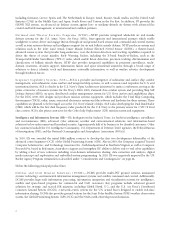Raytheon 2010 Annual Report Download - page 17
Download and view the complete annual report
Please find page 17 of the 2010 Raytheon annual report below. You can navigate through the pages in the report by either clicking on the pages listed below, or by using the keyword search tool below to find specific information within the annual report.pricing and cost, contract termination and adjustment, and audit requirements. A contractor’s failure to comply with
these regulations and requirements could result in reductions to the value of contracts, contract modifications or
termination, and the assessment of penalties and fines and lead to suspension or debarment, for cause, from government
contracting or subcontracting for a period of time. In addition, government contractors are also subject to routine audits
and investigations by U.S. Government agencies such as the Defense Contract Audit Agency (DCAA) and Defense
Contract Management Agency (DCMA). These agencies review a contractor’s performance under its contracts, cost
structure and compliance with applicable laws, regulations and standards. The DCAA also reviews the adequacy of and a
contractor’s compliance with its internal control systems and policies, including the contractor’s purchasing, property,
estimating, compensation and management information systems. For a discussion of certain risks associated with
compliance with U.S. Government contract regulations and requirements, see Item 1A “Risk Factors” of this Form 10-K.
U.S. Government contracts include both cost reimbursement and fixed-price contracts. Cost reimbursement contracts,
subject to a contract-ceiling amount in certain cases, provide for the reimbursement of allowable costs plus the payment
of a fee. These contracts fall into three basic types: (i) cost plus fixed fee contracts which provide for the payment of a
fixed fee irrespective of the final cost of performance, (ii) cost plus incentive fee contracts which provide for increases or
decreases in the fee, within specified limits, based upon actual cost results compared to contractual cost targets, and
(iii) cost plus award fee contracts which provide for the payment of an award fee determined at the discretion of the
customer based upon the performance of the contractor against pre-established criteria. Under cost reimbursement type
contracts, the contractor is reimbursed periodically for allowable costs and is paid a portion of the fee based on contract
progress. Some costs incident to performing contracts have been made partially or wholly unallowable for reimbursement
by statute, FAR or other regulation. Examples of such costs include charitable contributions, certain merger and
acquisition costs, lobbying costs, interest expense and certain litigation defense costs.
Fixed-price contracts are either firm fixed-price contracts or fixed-price incentive contracts. Under firm fixed-price
contracts, the contractor agrees to perform a specific scope of work for a fixed price and as a result, benefits from cost
savings and carries the burden of cost overruns. Under fixed-price incentive contracts, the contractor shares with the
government savings accrued from contracts performed for less than target costs and costs incurred in excess of targets up
to a negotiated ceiling price (which is higher than the target cost) and carries the entire burden of costs exceeding the
negotiated ceiling price. Accordingly, under such incentive contracts, the contractor’s profit may also be adjusted up or
down depending upon whether specified performance objectives are met. Under firm fixed-price and fixed-price
incentive type contracts, the contractor usually receives either milestone payments equaling up to 90% of the contract
price or monthly progress payments from the government generally in amounts equaling 80% of costs incurred under
government contracts. The remaining amount, including profits or incentive fees, is billed upon delivery and acceptance
of end items under the contract. For a discussion of certain risks associated with fixed price and cost reimbursement
contracts, see Item 1A “Risk Factors” of this Form 10-K.
U.S. Government contracts generally also permit the government to terminate the contract, in whole or in part, without
prior notice, at the government’s convenience or for default based on performance. If a contract is terminated for
convenience, the contractor is generally entitled to payments for its allowable costs and will receive some allowance for
profit on the work performed. If a contract is terminated for default, the contractor is generally entitled to payments for
its work that has been accepted by the government. The U.S. Government’s right to terminate its contracts has not had a
material adverse effect upon our operations or financial condition. For a discussion of the risks associated with the U.S.
Government’s right to terminate its contracts, see Item 1A “Risk Factors” of this Form 10-K.
U.S. Government programs generally are implemented by the award of individual contracts and subcontracts. Congress
generally appropriates funds on a fiscal year basis even though a program may extend across several fiscal years.
Consequently, programs are often only partially funded initially and additional funds are committed only as Congress
makes further appropriations. The contracts and subcontracts under a program generally are subject to termination for
convenience or adjustment if appropriations for such programs are not available or change. The U.S. Government is
required to equitably adjust a contract price for additions or reductions in scope or other changes ordered by it. For a
discussion of the risks associated with program funding and appropriations, see Item 1A “Risk Factors” and “Overview”
within Item 7 of this Form 10-K. In addition, because we are engaged in supplying technologically-advanced, cutting edge
defense-related products and services to the U.S. Government, we are subject to certain business risks, some of which are
9
























